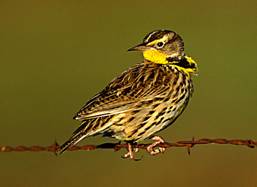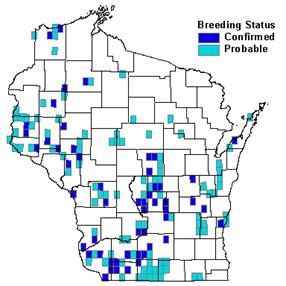Photo by Eric Preston


Status/Protection
- Global Rank: G5 Key to global and state ranks
- State Rank: S2B
- WBCI Priority: SGCN, PIF, State Special Concern
Population Information
The Federal BBS information can be obtained at http://www.mbr-pwrc.usgs.gov/bbs/bbs.html by clicking on Trend Estimates and selecting the species in question. All estimates are for time period (1966-2005).
- Federal Breeding Bird Survey: significant decline
- Federal Breeding Bird Survey (WI): significant decline
- Federal Breeding Bird Survey (BCR 23): significant decline
- Federal Breeding Bird Survey (BCR 12): significant decline
- WSO Checklist Project: Decreasing (1983-2007)
Life History
- Breeding Range: Pacific Coast west to northwestern Ohio south through Mexico (Lanyon 1994).
- Breeding Habitat: Pasture, Hay, Idle Cool-season Grasses, Idle Warm-season Grasses, Dry Prairie, Dry-mesic Prairie, Pine Barrens.
- Nest: Ground, nest usually partially arched or roofed (Lanyon 1994).
- Nesting Dates: Eggs: late-April to mid-July (Robbins 1991).
- Foraging: Ground glean, probes.
- Migrant Status: Short-distance migrant.
- Habitat use during Migration: Cultivated fields, open country.
- Arrival Dates: Early April.
- Departure Dates: Mid-September to early November.
- Winter Range: Northern Illinois to Gulf of Mexico west, Mexico.
- Winter Habitat: Cultivated fields, open country, feed lots.
Habitat Selection
Western Meadowlarks inhabit pastures and small grain fields. This species also occurs in other short, open grasslands and agriculture fields including hayfields, short to medium height idle grasslands, dry old fields, dry-mesic prairies, and open barrens. Western Meadowlarks typically are found in drier and more open areas than Eastern Meadowlarks, although both can be found in the same habitat patch (Niemuth 2006). Additionally, Western Meadowlarks tend to prefer habitats with less woody cover and shorter vegetation height-density than Eastern Meadowlark (Sample and Mossman 1997).
Habitat Availability
Native grasslands have been almost completely lost since European settlement, and agricultural land has undergone many changes, from the era of wheat farming in the late 1800s, to the dominance of dairy farming in the mid-1900s, to the growth of row cropping in recent decades (Sample 1989). Existing parcels of native grasslands in the state are few, and those remaining are vulnerable to fragmentation, row crop conversion, urban development, and forest succession. Pastures, small grains, dry old fields, and hayfields are more common, but are still subject to the same threats.
Population Concerns
The Western Meadowlark population in Wisconsin has experienced extreme fluctuations over the last 100 years. There are very few records of this species in the state prior to 1900 (Lanyon 1953). By 1922, the Western Meadowlark was reported as abundant and equally numerous as the Eastern Meadowlark in southern and western Wisconsin (Stoddard 1922). During the 1940s the Western Meadowlark invasion was found to have penetrated into the extreme northern regions of the state. This range expansion was likely due in part to changing agricultural practices (i.e., livestock and dairy farming) that favored Western Meadowlark habitat needs (Lanyon 1953).
Since 1980 Breeding Bird Survey data show significant population declines of Western Meadowlarks in Wisconsin and surrounding states (Sauer et al. 2005). The Western Meadowlark remains widespread in the southwestern region of the state, which contains the highest acreages of prairie remnants, pastures, and Conservation Reserve Program lands (Sample and Mossman 1997). However, during the six-year period (1995-2000) of the Wisconsin Breeding Bird Atlas, observers were able to confirm breeding on only 53 of the 1,130 quads surveyed (Niemuth 2006). The same factor that contributed to the Western Meadowlark’s range expansion into this state in the early twentieth century is now likely contributing to its decline. Changing agricultural practices, in particular the conversion of pastures and small grain crops to row crops has decreased the suitability of agricultural habitat for grassland bird species (Graber and Graber 1963). Additionally, surface tillage for spring weed control and early harvesting of hayfields can lead to reproductive failure for this species (Lanyon 1994).
Recommended Management
Management strategies to benefit Western Meadowlarks include protecting large, native grassland areas from conversion to agricultural production, treating (burn, graze, or mow) portions of large areas on a rotational schedule to provide a mosaic of successional stages, controlling the encroachment of woody vegetation, mowing hayfields in late summer (after July 15), and undercutting wheat stubble in the spring instead of using surface tilling (Dechant et al. 1999). Conservation strategies for this species should be focused in the following Wisconsin ecological landscapes: Central Sand Hills, Central Sand Plains, Southeast Glacial Plains, Southwest Savanna, Western Coulee and Ridges, and Western Prairie (WDNR 2005). Within these landscapes, public lands important for the management of this species include Thomson Prairie Grasslands and Yellowstone/Pecatonica River Grasslands and Savannas (David Sample, pers. comm.).
Research Needs
More research is needed on the winter distribution and habitat requirements for the northeastern population of Western Meadowlarks. Continued monitoring and investigation into this species’ population decline also is needed. Additional data are needed on the extent of hybridization with the Eastern Meadowlark at the eastern periphery of the breeding range (Lanyon 1994).
Information Sources
- Knutson, M.G., G. Butcher, J. Fitzgerald, and J. Shieldcastle. 2001. Partners in Flight Bird Conservation Plan for The Upper Great Lakes Plain (Physiographic Area 16). USGS Upper Midwest Environmental Sciences Center in cooperation with Partners in Flight. La Crosse, WI.
- Managing Habitat for Grassland Birds: A Guide for Wisconsin: http://www.npwrc.usgs.gov/resource/birds/wiscbird/
- North American Breeding Bird Survey: http://www.npwrc.usgs.gov
- Temple S.A., J.R. Cary, and R. Rolley. 1997. Wisconsin Birds; A Seasonal and Geographical Guide. Wisconsin Society of Ornithology and Wisconsin Department of Natural Resources, Madison, WI.
- Wisconsin Breeding Bird Atlas: http://www.uwgb.edu/birds/wbba/
- David Sample, Grassland Community Ecologist, Wisconsin DNR - 608-221-6351
References
- Dechant, J.A., M.L. Sondreal, D.H. Johnson, L.D. Igl, C.M. Goldade, A.L. Zimmerman, and B.R. Euliss. 1999. Effects of management practices on grassland birds: Western Meadowlark. Northern Prairie Wildlidfe Research center, Jamestown, ND. 32pp.
- Graber, R.R. and J.W. Graber. 1963. A comparative study of bird populations in Illinois, 1906-1909 and 1956-1958. Illinois Natural History Survey Bulletin 28:378-528.
- Lanyon, W.E. 1953. Meadowlarks in Wisconsin. Part 1, Historical and ecological aspects of distribution. Passenger Pigeon 15(3):99-112.
- Lanyon, W.E. 1994. Western Meadowlark (Sturnella neglecta). In the Birds of North America, No. 104 (A. Poole and F. Gill eds.). Philadelphia: The Academy of Natural Sciences; Washington, D.C.: The American Ornithologists’ Union.
- Niemuth, N. 2006. Western Meadowlark. In Atlas of the Breeding Birds of Wisconsin. (N.J. Cutright, B.R. Harriman, and R.W. Howe, eds.) The Wisconsin Society for Ornithology, Inc. 602pp.
- Robbins, S. D., Jr. 1991. Wisconsin Birdlife: Population and distribution past and present. Madison, WI: Univ. Wisconsin Press.
- Sample, D.W. 1989. Grassland birds in southern Wisconsin: habitat preference, population trends, and response to land use changes. M.S. thesis. University of Wisconsin, Madison, WI. 588pp.
- Sample, D. and M. Mossman. 1997. Managing Habitat for Grassland Birds: A Guide for Wisconsin. Wisconsin Department of Natural Resources: Madison, WI.
- Sauer, J.R., J.E. Hines, and J. Fallon. 2005. The North American Breeding Bird Survey, Results and Analysis 1966 - 2005. Version 6.2.2006. USGS Patuxent Wildlife Research Center, Laurel, MD.
- Stoddard, H.L. 1922. Bird Notes from Southern Wisconsin. Wilson Bulletin 34:67-89.
Contact Information
- Compiler: Jenny Herrmann, mherrmann4@wi.rr.com
- Editors: Kim Kreitinger, K.Kreitinger@gmail.com
